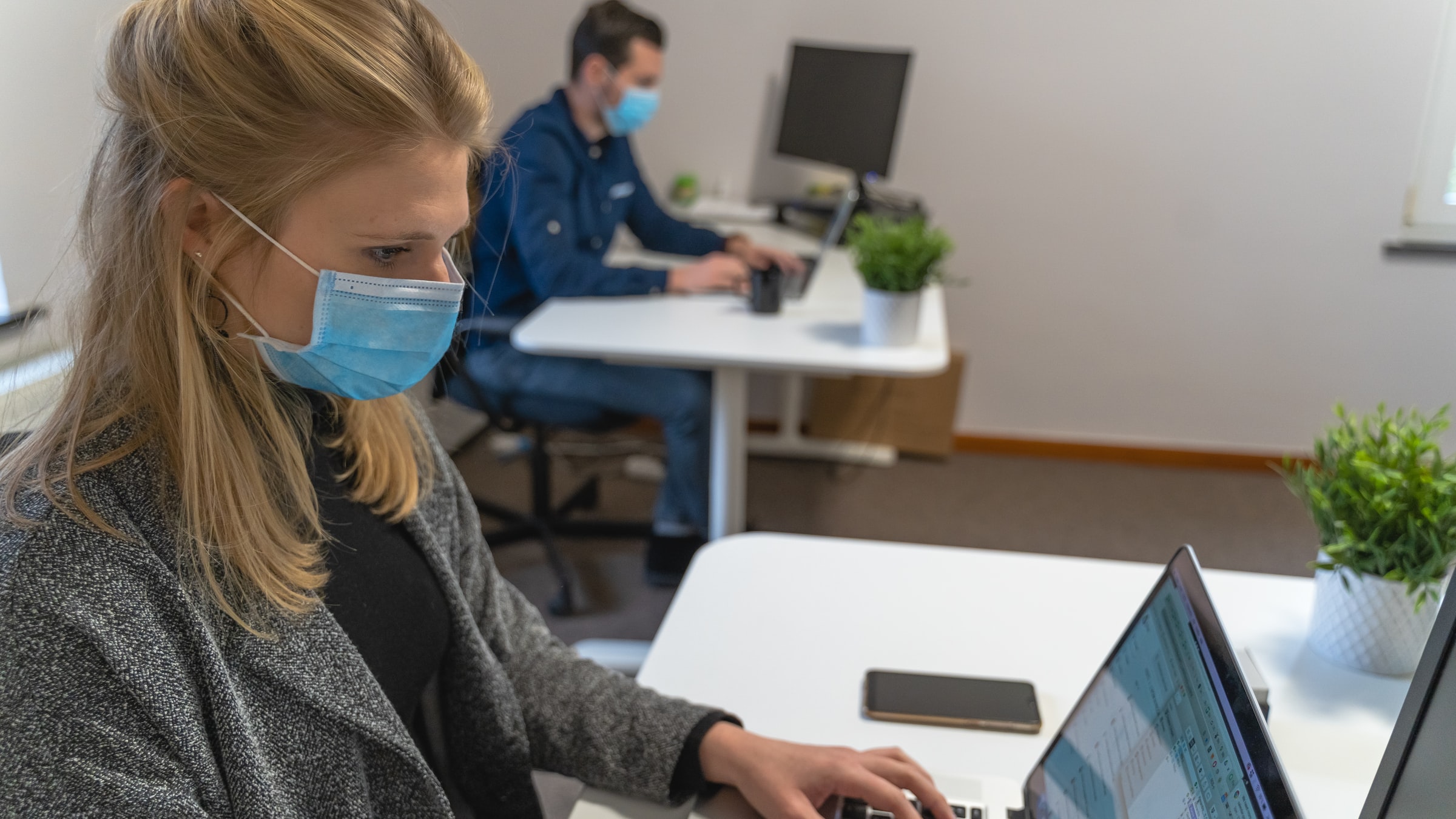The Future of Work – What’s next for hygiene in workspaces?
Remember the lone sandwich in the fridge that went unclaimed for three months?
By the time someone took the initiative to throw it out, it’d developed a toxic mould so thick the retrieving party had to don a pair of rubber gloves and a facemask to go near it.
Fortunately, anecdotes like these could be well and truly become a thing of the past now that hygiene practices are evolving and improving due to the pandemic.
Although some of the more drastic hygiene measures could eventually be eased, we expect that the general change in attitude towards cleanliness in offices will prevail.
Before we take a look at some of the broader hygiene trends shaping up in today’s workspaces, let’s remind ourselves of some of the cleaning measures offices are currently implementing to help curb the spread of coronavirus.

Enhanced cleaning is set to continue after the coronavirus lockdown.
Signage to help workers practice good handwashing techniques
Fog, mist, vapour or UV treatments for larger spaces
Frequent cleaning of work areas and equipment between uses
Limiting or restricting use of high-touch items/equipment
Extra bins for workers and visitors to dispose of single use face coverings/PPE
Hand sanitiser in multiple accessible locations
Enhanced/regular cleaning of all facilities during the day and at the end of the day
Regular and ramped up cleaning procedures for vehicles
Adjustment of mechanical ventilation systems if necessary, e.g. so that they don’t automatically reduce ventilation when occupancy levels are lower.
(Find out more at gov.uk and hse.gov.uk.)
1. Preventative cleaning
Covid-19 is spread through droplets, aerosols and direct contact, and let’s face it, surfaces and objects in offices are easy targets for contamination. As well as social distancing and good ventilation, thorough cleaning is the key to keeping the presence of the virus at bay.
Regular and enhanced cleaning also helps give employees the confidence to continue utilising workspaces. However, cleaning isn’t just one person’s job - it’s a communal effort.
Moving forward, workplaces will need to prioritise educating employees in basic office hygiene etiquette and the benefits associated with it. Training everyone in how to follow hygiene guidelines will help ensure that workspaces remain safe for workers and visitors.
2. Commercial cleaning services
Unsurprisingly, the Covid-19 pandemic has led to an increase in demand for quality office cleaning services. Enlisting the help of hygiene specialists can provide workspace operators and occupiers alike with peace of mind in uncertain and ever-evolving circumstances.
Quality contractors are ahead of the curve when it comes to best Covid-19 cleaning practices and protocols. Outsourcing a large portion of the cleaning work can also take some of the burden off workspace managers who already have a lot to deal with.

Delegating cleaning to external providers can reduce stress; however, preventative measures are still necessary.
Reputable cleaners receive Covid-19 health and safety training. What’s more, as well as being equipped with the knowledge required to tackle the spread of germs in offices, they possess the equipment and products required to carry out cleaning to the highest standard.
We also expect that there will be more consultation between the client and cleaning company. This will equip the latter with an understanding of which areas require more attention and when to carry out tasks to ensure minimum disruption/maximum efficiency.
3. Reimagining office layouts
Workspace architects and designers predict that the pandemic could give way to a new type of office design that is inspired by healthcare facilities like hospitals.
Brent Capron is interior Design Director at Perkins and Will. In an article for BBC Worklife, he explains how hospital design elements are being applied to the office.
“One of the guiding principles is choosing materials that can withstand heavy cleaning using caustic products. You’ll see porous surfaces like natural oiled wood avoided, with a preference for stone or laminates,” he says.
Capron also expects that office layouts will evolve so as to minimise touchpoints and improve overall operational efficiency.
“Doctors’ work is so urgent and their time is so precious that they will find the fastest way to get from point A to point B. We, too, will be more focused on getting from A to B in a very direct manner, and conscious of what we're touching along the way.”
4. Better sickness and wellness policies
To combat Covid and future viruses (as well as the ongoing presenteeism crisis), some employers are beginning to rethink their sickness policies.
The future of work has no place for feelings of guilt when it comes to taking time of work to recuperate. It’s more important than ever for employees to stay at home and rest when they’re feeling unwell. To avoid infecting others, of course, and for their own health.
Workplaces also need to consider mental health. If you run a business now’s the time to train up some of your staff in mental health first aid so that they’re able to identify when someone might be struggling and need help. Mental health first aiders act as a supportive point of contact and are trained to signpost people to the relevant resources.

Research conducted in 2019 by Accountemps revealed that 90% of employees went into work when feeling under the weather and 57% sometimes went in while sick.
Prioritising workers’ psychological wellbeing by allowing them to take personal and mental health days is a must. Having a healthy attitude towards health benefits everyone. After all, a healthier and happier workforce is a more productive and dedicated one!
Next time, we’ll be taking honing in on the role of virtual communication in the future of work.
Related stories
Flexible Workspaces Management: Simplifying Corporate Success
Working from home is indeed not a new concept, at all! AT&T started to eliminate unused offices in 1991. Three years later, as part of an experiment to explore the extent to which a large organisation could revolutionise the workplace by bringing work to the employees, it had 32,000 employees working from home.
State of Remote Work 2021: What does it mean for coworking and flex workspaces?
Owl Labs recently published their 2021 State of Remote Work Report. In this article, we take a look at some of the key findings and consider what they mean for coworking and flexible workspaces.
Future of Work – What's next for the human experience in coworking and flexible workspaces?
For our final Future of Work article, we take a look at the Human Experience and how this is driving all other trends we have covered in this series. Treating members as individuals is what coworking does best, but there is never a bad time to reassert your care and devotion to your members.
The Future of Work – What’s next for the daily commute?
Is the daily commute worth it? Although people certainly miss the collaboration offered by office working, the commute is something that hasn’t been missed as much. So what does this mean moving forward, and how will the daily commute change as we move into a post-covid world?
The Future of Work – What's next for purpose-driven values in coworking and flexible workspaces
Very few people get into the coworking business just to make money quickly. It takes time to develop a coworking space into a profitable business, which is why many operators focus instead on being purpose-driven organisations. This week’s Future of Work article focuses on how to instill purpose-driven values into your space.
The Future of Work – What’s next for upskilling in coworking and flexible workspaces?
Increasingly, businesses in every sector are discovering the importance of upskilling, a great way to boost the skillset of your team. Coworking is not exempt from this as they are in the position to boost the skills of not only their staff but their members too!
The Future of Work – What’s next for diversity and inclusion in coworking and flexible workspaces?
With increasing scrutiny placed on businesses to employ proper measures to ensure a diverse and inclusive workforce, it's vital to have a proper understanding of the terms diversity and inclusion and what they mean. This week's Future of Work article focuses on this vitally important issue, and what coworking spaces can do to make sure they are doing their part for this essential movement.
The Future of Work – What's next for digital communication?
The way we all communicate has changed drastically over the past year, and as much as we all want to get back to normal, it seems likely that this kind of digital communication will be with us for some time yet. This week, we focus on how digital communication will impact the future of work for years to come.
The Future of Work – What’s next for sustainability in the workplace?
The third focus article in our Future of Work series takes a look into sustainability, and how workspaces can make changes to reduce their impact on the environment. We offer a number of different tactics that can be taken, from small changes to more wide-ranging ones.
The Future of Work – What's next for employee health and wellbeing?
The second focus article in our future of work series takes a deeper look at the trends in employee health and wellbeing. This is an area that has seen growing attention over the past few years, and this very much looks set to continue into the future.

